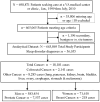Sleep disorders and cancer incidence: examining duration and severity of diagnosis among veterans
- PMID: 38469244
- PMCID: PMC10927008
- DOI: 10.3389/fonc.2024.1336487
Sleep disorders and cancer incidence: examining duration and severity of diagnosis among veterans
Abstract
Introduction: Sleep disruption affects biological processes that facilitate carcinogenesis. This retrospective cohort study used de-identified data from the Veterans Administration (VA) electronic medical record system to test the hypothesis that patients with diagnosed sleep disorders had an increased risk of prostate, breast, colorectal, or other cancers (1999-2010, N=663,869). This study builds upon existing evidence by examining whether patients with more severe or longer-duration diagnoses were at a greater risk of these cancers relative to those with a less severe or shorter duration sleep disorder.
Methods: Incident cancer cases were identified in the VA Tumor Registry and sleep disorders were defined by International Classification of Sleep Disorder codes. Analyses were performed using extended Cox regression with sleep disorder diagnosis as a time-varying covariate.
Results: Sleep disorders were present among 56,055 eligible patients (8% of the study population); sleep apnea (46%) and insomnia (40%) were the most common diagnoses. There were 18,181 cancer diagnoses (41% prostate, 12% colorectal, 1% female breast, 46% other). The hazard ratio (HR) for a cancer diagnosis was 1.45 (95% confidence interval [CI]: 1.37, 1.54) among those with any sleep disorder, after adjustment for age, sex, state of residence, and marital status. Risks increased with increasing sleep disorder duration (short [<1-2 years] HR: 1.04 [CI: 1.03-1.06], medium [>2-5 years] 1.23 [1.16-1.32]; long [>5-12 years] 1.52 [1.34-1.73]). Risks also increased with increasing sleep disorder severity using cumulative sleep disorder treatments as a surrogate exposure; African Americans with more severe disorders had greater risks relative to those with fewer treatments and other race groups. Results among patients with only sleep apnea, insomnia, or another sleep disorder were similar to those for all sleep disorders combined.
Discussion: The findings are consistent with other studies indicating that sleep disruption is a cancer risk factor. Optimal sleep and appropriate sleep disorder management are modifiable risk factors that may facilitate cancer prevention.
Keywords: apnea; cancer; insomnia; risk; sleep; veteran.
Copyright © 2024 Burch, Delage, Zhang, McLain, Ray, Miller, Adams and Hébert.
Conflict of interest statement
Author AD is currently employed by Palmetto GBA, LLC. When the study was conducted, she was employed by the University of South Carolina. The remaining authors declare that the research was conducted in the absence of any commercial or financial relationships that could be construed as a potential conflict of interest.
Figures

Similar articles
-
Comorbid Insomnia and Sleep Apnea are Associated with Greater Downstream Health Care Utilization and Chronic Opioid Use after Arthroscopic Hip Surgery.Pain Physician. 2019 Jul;22(4):E351-E360. Pain Physician. 2019. PMID: 31337179
-
Insomnia and Early Incident Atrial Fibrillation: A 16-Year Cohort Study of Younger Men and Women Veterans.J Am Heart Assoc. 2023 Oct 17;12(20):e030331. doi: 10.1161/JAHA.123.030331. Epub 2023 Oct 4. J Am Heart Assoc. 2023. PMID: 37791503 Free PMC article.
-
Prevalence of insomnia disorder and sleep apnea in a sample of veterans at risk for cardiovascular disease.J Clin Sleep Med. 2021 Jul 1;17(7):1441-1446. doi: 10.5664/jcsm.9228. J Clin Sleep Med. 2021. PMID: 33688827 Free PMC article.
-
Association of obstructive sleep apnea and nocturnal hypoxemia with all-cancer incidence and mortality: a systematic review and meta-analysis.J Clin Sleep Med. 2022 May 1;18(5):1427-1440. doi: 10.5664/jcsm.9772. J Clin Sleep Med. 2022. PMID: 34755597 Free PMC article.
-
Prevalence and management of sleep disorders in the Veterans Health Administration.Sleep Med Rev. 2020 Dec;54:101358. doi: 10.1016/j.smrv.2020.101358. Epub 2020 Jul 20. Sleep Med Rev. 2020. PMID: 32791487 Review.
References
-
- Ford ES, Wheaton AG, Cunningham TJ, Giles WH, Chapman DP, Croft JB. Trends in outpatient visits for insomnia, sleep apnea, and prescriptions for sleep medications among US adults: findings from the national ambulatory medical care survey 1999-2010. Sleep (2014) 37(8):1283–93. doi: 10.5665/sleep.3914 - DOI - PMC - PubMed
LinkOut - more resources
Full Text Sources

